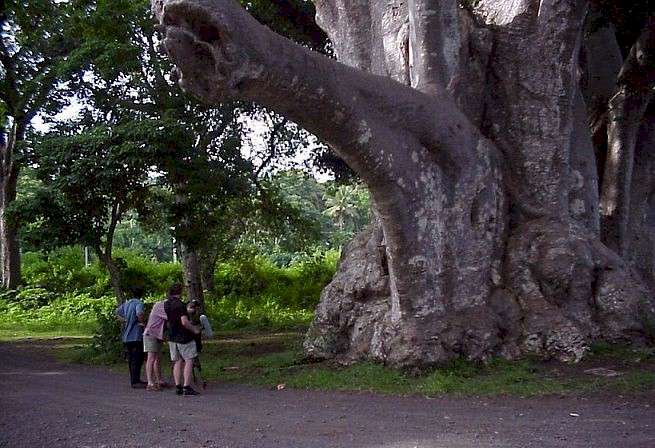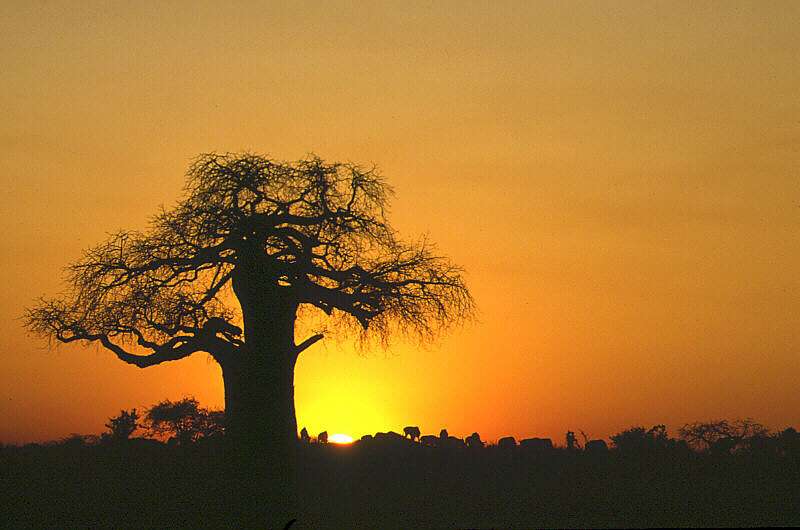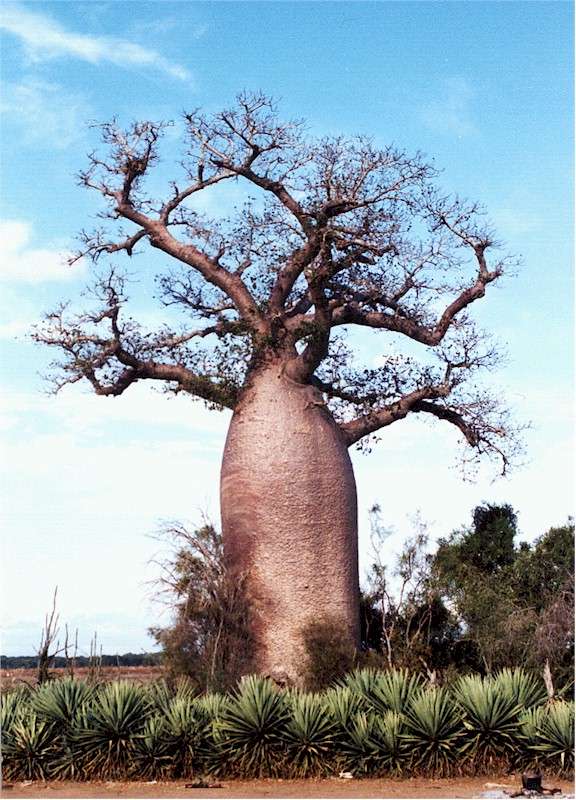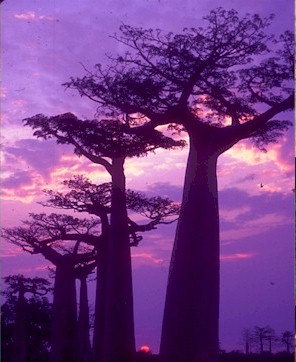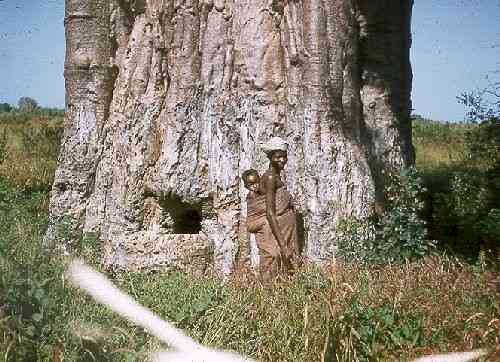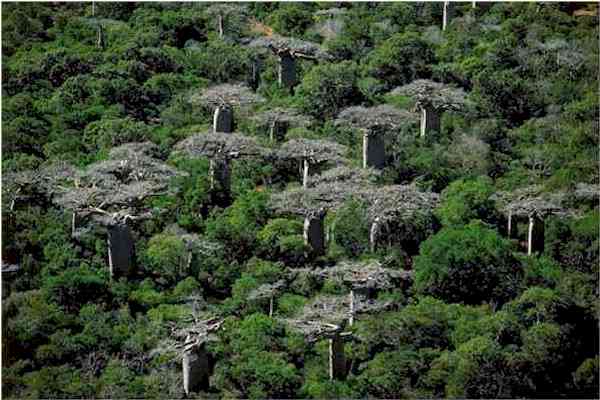The Jewel of the Savannah
The Beautiful BaobabWe all travel the milky way together, trees and men... trees are travellers, in the ordinary sense. - John Muir It is not so much for its beauty that the forest makes a claim upon men's hearts, - Robert Louis Stevenson Death is a low chemical trick played on everybody except baobab trees. - JJ Furnas The origin of the name baobab is uncertain. Some have suggested that it comes from "bu hobab," a name used for the plant in the markets of Cairo. Or perhaps it was derived from "bu hibab," an Arabic designation for "the fruit with many seeds." The trees are related to the kapok and the balsa. There are 6 species of baobab trees in Madagascar, 1 in Africa and 2 elsewhere (including Australia and Vietnam). The baobab trees (called renala by inhabitants of Madagascar) are present almost everywhere on the island, except in the highlands and rain forest. They are most prevalent in the dry savannah of the West. For centuries, much of what was known about baobabs was based exclusively on the African baobab (A digitata). The first recorded reference was by 14th-century Arab traveller Ibn Batuta who mentions the water-storage capacity of its massive trunk. In 1661 the writer Flacourt praised the giants - speaking about the area of Morondava, he wrote: "It is in this region that exists a tree named Anadzahé, which is monstrously stupendously large. It is hollow inside and 12 feet in diameter, round, ending in an archway like the bottom of a lamp. There are only a few small branches here and there on top. The tree is a wonder to be seen." Well, I think he was right...
Source: ctm.mayotte.free.fr Sometimes called the "upside-down tree" because of their unusual root-like branch formations, baobabs are extremely long-lived. Some specimens are believed to be more than 3,000 years old. (Two trees on an island off Cape Verde were estimated to be over 5,000 years old. Those trees have since disappeared, however, so the claim can no longer be verified.) Girth measurements themselves are not reliable estimates of a particular tree's age, as the conditions under which it has grown - and the climatic fluctuations of the centuries - strongly affect them - some years, they can decrease in size. There is no such thing as a "typical" baobab. Inside its shell, the tree's fruit contains a number of seeds, embedded in a whitish, powdery pulp. Tangy and exceedingly nutritious, the pulp makes a tasty food or, after soaking in water or milk, a refreshing beverage (with 6 times the vitamin C content of an orange). Fermented, it makes a traditional brew. The seeds may be eaten raw or roasted. They yield an edible oil which is used for cooking and exported for use in cosmetics. The leaves, similar to spinach, are eaten as a relish, especially in times of drought and are considered medicinal - they reduce fever and diarrhœa. The pollen of the African and Australian baobabs is mixed with water to make glue. The wood has a moisture content of 40%, making it unusuable as timber (which is lucky for the tree because it keeps it from being harvested) but the fibrous bark can be made into baskets, rugs, fishing nets, hats, ropes and the like. The tree seems impervious to having its bark stripped. (That's good, because elephants strip and eat all they can find.)
Source: space.tin.it Baobab (called kuka trees in Nigeria) flower for the first time at about 20 years. In mid-summer, dozens of luminous white blossoms - the size of saucers - open at sunset and their strong musky odour attracts fruit bats and hosts of insects. Large bats seek out the generous sweet nectar and collect and distribute pollen as they move from flower to flower. The life of a flower is short lived and it drops to the ground within hours. The resultant seeds are housed in a hairy pod which resembles a miniature rugby ball (inside of which is a white pulp from which cream of tartar is derived). Once they fall to the ground, the pods are fed upon by baboons, monkeys, antelope and elephants, which serve to disperse the hard seeds within. Humans eat them as well. Bushbabys, squirrels, rodents, lizards, snakes, tree frogs, spiders, scorpions and insects may live out their entire lives in a single tree. Birds nest in holes in the trunk. The hollow trunks of living trees have served as homes, storage barns, places of refuge or worship, and even as prisons or tombs. One tree near Gravelotte in South Africa's Northern Province was used as a bar where up to a dozen thirsty gold diggers could quench their thirst.
Source: acro.harvard.edu Certain tribes in the Transvaal wash baby boys in water soaked in the bark of a baobab. Then, like the tree, they will grow up mighty and strong. To this day the baobab remains at the centre of black magic rituals on the islands where they are found. Most waganga will take their subjects to a special tree, where they may tie ornaments to the branches to give a spell its power, hammer nails into the trunk to kill devils, or climb and sit in the branches whilst carrying out various ceremonies. The wood being soft, it is subject to attacks of fungus which destroy its life, and renders the part affected easily hollowed out. This is done by natives, and within these hollows they suspend the dead bodies of those who are refused the honor of burial. There they become mummies - perfectly dry and well preserved - without any further preparation of embalmment.
Masagascar Source: www.bluechameleon.org The baobab in Africa is most at risk in wildlife reserves where confined populations of elephants may outstrip their resources and demolish and consume whole trees in their struggle for survival. How large an area does a species need to maintain a healthy reproducing population? How much habitat destruction can a species stand before its pollinator spectrum begins to unravel? Answers to these kinds of questions are essential in any effort to make informed decisions about conservation and resource management. At present, the future of the Australian baobab seems secure. Survival of the African baobab and at least two Malagasy species (A rubrostipa and A za) also seems likely because of their comparatively widespread ranges and broad ecological tolerances. The long-term prognosis for the four Malagasy baobabs with more restricted distributions is a matter of concern because of ongoing habitat destruction that is accelerating along with population growth.
The hole at the base of this baobab served as the doorway for a wild pig Like sentinels of a past era, baobabs have been able to survive in denuded landscapes because of the phenomenal water-storage capacity of their trunks and their extensive horizontal root systems, which glean any available surface moisture. However, the lack of seedlings and young trees is distressing, serving as a potent reminder that recurrent fires, seed predation, and perhaps competition from aggressive weeds are restricting regeneration of these gnarled giants.
Source: www.barbados.org © Ian Clayton AXSES Incorporated The baobab tree (Adansonia digitata) was brought to Barbados around 1738 from Guinea in Africa. It is also known as the "Monkey-bread tree". Two magnificent trees with possibly the widest tree-trunks to be found in the Caribbean, grow in Barbados. The largest can be seen in Queen's Park in Bridgetown. To give an example of the size of this tree of great distinction, it takes 15 adults joining with outstretched arms to cover its circumference. Source: wildwatch.com
Baobabs south of Belo, Toliara region, Madagascar (S 19°42'-E 44°33') The fourth largest island on earth, Madagascar is slightly larger than France. It separated from Africa more than 100 million years ago, and its plants and animals have since evolved independently – 80% of its species are endemic to the island. Among these are 7 of the world’s 8 known species of baobab. These trees can store several thousand liters (about a thousand gallons) of water in their huge barrel-shaped trunks, allowing them to survive the dry season, which in the Toliara region lasts from April to November. Baobabs are a precious resource. Their bark is used to build huts and manufacture ropes; their fruits, similar to gourds, and their leaves, which are rich in calcium, are eaten; the seeds are crushed to extract their oil, used to make soap; and the trees’ sap is used in manufacturing paper. The ingenious use of local natural resources is a reminder that many species contain precious resources (notably chemicals and pharmaceuticals). This is one argument for conserving biodiversity, as agreed at the Earth Summit held in Rio de Janeiro in 1992. Source: yannarthusbertrand.com from Earth from Above by the incomparable photographer Yann Arthus-Bertrand
Fruit with 6 Times the Vitamin C of an Orange Heading for UK Supermarkets
The tart pulp inside the velvety but hard shell of the baobab pod encases small round seeds by Sophie Borland It is one of the strangest fruits under the sun and has been revered in Africa for thousands of years. Now the bounty from the baobab tree is heading to British supermarkets after the EU agreed to allow it to be imported for the first time. The fruit, which from the outside looks like a coconut, contains 6 times more vitamin C than oranges and 2 times as much calcium as milk. In its native Africa, it has provided health benefits for generations. The pulp, which is white, powdery and has a cheese-like texture, is extremely nutritious and high in anti-oxidants, iron and potassium. The baobab (or upside-down tree, as it is also known) is cherished by locals who believe that its spirit protects villages. Only specially trained climbers are allowed to scale the branches to retrieve the fruit. Once the hard outer shell has been broken the flesh can be eaten straight away, although it has a slightly sour flavour. In some parts of East Africa the fruit is covered in a red, sugary coating and sold as sweets. Because the shell is so hard to crack, it will not be available to buy as a whole fruit in Britain. Instead, it will provide ingredients for smoothies and cereal bars. The fruit was finally allowed to be imported into the UK following extensive lobbying by Phytotrade. Under current legislation, foods which have not been commonly consumed in the EU before 1997 have to be formally approved before they can go on sale or used in European food and drink products. The organisation submitted an application for the fruit to be imported in 2006 and the EU yesterday announced its approval. It is hoped that the demand will enable millions of poor families in Africa to earn a living growing and harvesting the fruit. Gus Le Breton, chief executive of PhytoTrade Africa, said: "The EU decision is a crucial step to developing the global market which could be worth up to £500 million a year. Baobab is an ideal ingredient for smoothies and cereal bars, and its well documented nutritional benefits provide manufacturers with a new opportunity to target the booming market in healthy foods. Dozens of companies have shown interest in baobab since we submitted the application and many have already conducted initial research. Now that approval has been given, they can progress to full-scale product development." Source: dailymail.co.uk 15 July 2008
-------- Original Message -------- Comments: Hello there from England. I'm writing in the slim hope you may be able to help me. I am a very enthusiastic timber sample collector (member of International Wood Collectors Society) and have well over 3000 different samples. One eludes me though! I fully realise that Adansonia digitata does not produce timber as such, but I'm keen to get hold of some from which I can make a sample of approx 6"x3"x0.5". Do you have any idea of how I can obtain this please? Look forward to hearing from you. Your site is very interesting! Thank you. Reply: Can someone help Ken get a sample of baobab wood?
For pages on natural disasters - including lightning strikes, tornados, hurricanes, volcanoes, floods, global warming and more - as well as some great satellite photos,
clicking the "Up" button immediately below takes you to the Table of Contents page for this Environment section. |
 Animals
Animals Animation
Animation Art of Playing Cards
Art of Playing Cards Drugs
Drugs Education
Education Environment
Environment Flying
Flying History
History Humour
Humour Immigration
Immigration Info/Tech
Info/Tech Intellectual/Entertaining
Intellectual/Entertaining Lifestyles
Lifestyles Men
Men Money/Politics/Law
Money/Politics/Law New Jersey
New Jersey Odds and Oddities
Odds and Oddities Older & Under
Older & Under Photography
Photography Prisons
Prisons Relationships
Relationships Science
Science Social/Cultural
Social/Cultural Terrorism
Terrorism Wellington
Wellington Working
Working Zero Return Investment
Zero Return Investment